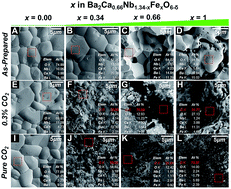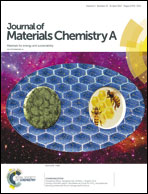Thermochemical CO2 splitting using double perovskite-type Ba2Ca0.66Nb1.34−xFexO6−δ†
Abstract
A carbon-neutral fuel is desired when it comes to solving the issues associated with climate change. A smart approach would be to develop new materials to produce such fuels, which could be integrated with renewables to improve the efficiency (e.g., solid oxide fuel cells (SOFCs) in smart grid and concentrated solar fuel technologies). In this study, we report the utilization of nonstoichiometric perovskite oxides, Ba2Ca0.66Nb1.34−xFexO6−δ (BCNF) (0 ≤ x ≤ 1), to split CO2 into carbon, carbon monoxide, and oxygen at elevated temperatures. Powder X-ray diffraction shows the chemical stability of double perovskite-type BCNF after being exposed to 2000 ppm CO2 in Ar at 700 °C. Furthermore, all x ≤ 0.66 BCNF members exhibit high chemical stability even under pure CO2 at 700 °C. Scanning electron microscopy coupled with energy dispersive X-ray, Raman spectroscopy, temperature programmed oxidation (TPO) and mass spectroscopy (MS), and DFT analyses confirm the formation of solid carbon upon CO2 exposure, which increases with increasing Fe in BCNF. Mössbauer spectroscopy of the as-prepared BCNF shows the presence of Fe3+, Fe4+ and Fe5+. Upon Ar exposure, the higher valent Fe component is reduced to Fe3+ and subsequent oxidation of Fe3+ seems to promote the CO2 reduction. Overall, these promising results of BCNFs, displaying redox activity at significantly lower temperatures compared to state-of-the-art ceria for CO2 reduction, show great potential for their use in renewable-driven fuel technologies.

- This article is part of the themed collection: CSC100: Celebrating Canadian Chemistry


 Please wait while we load your content...
Please wait while we load your content...